BP Oil Spill: Comprehensive Financial, Regulatory, and Market Analysis
VerifiedAdded on 2020/03/23
|7
|1588
|103
Report
AI Summary
This report examines the BP oil spill, also known as the Deepwater Horizon disaster, focusing on its financial and regulatory implications. It analyzes the significant environmental and economic damage caused by the spill, including the impact on the Gulf of Mexico, aquatic species, and various industries such as tourism and fishing. The report delves into the financial losses suffered by BP, including compensation programs and market capitalization decline, and critiques the failures of regulators in preventing the disaster. It also discusses the importance of corporate social responsibility and the need for stricter regulations to avoid similar incidents in the future. The analysis covers the immediate market reactions, stock price fluctuations, and the long-term consequences for BP and related entities. The report concludes by emphasizing the need for enhanced governance and regulatory oversight to ensure corporate responsibility and protect public interests.
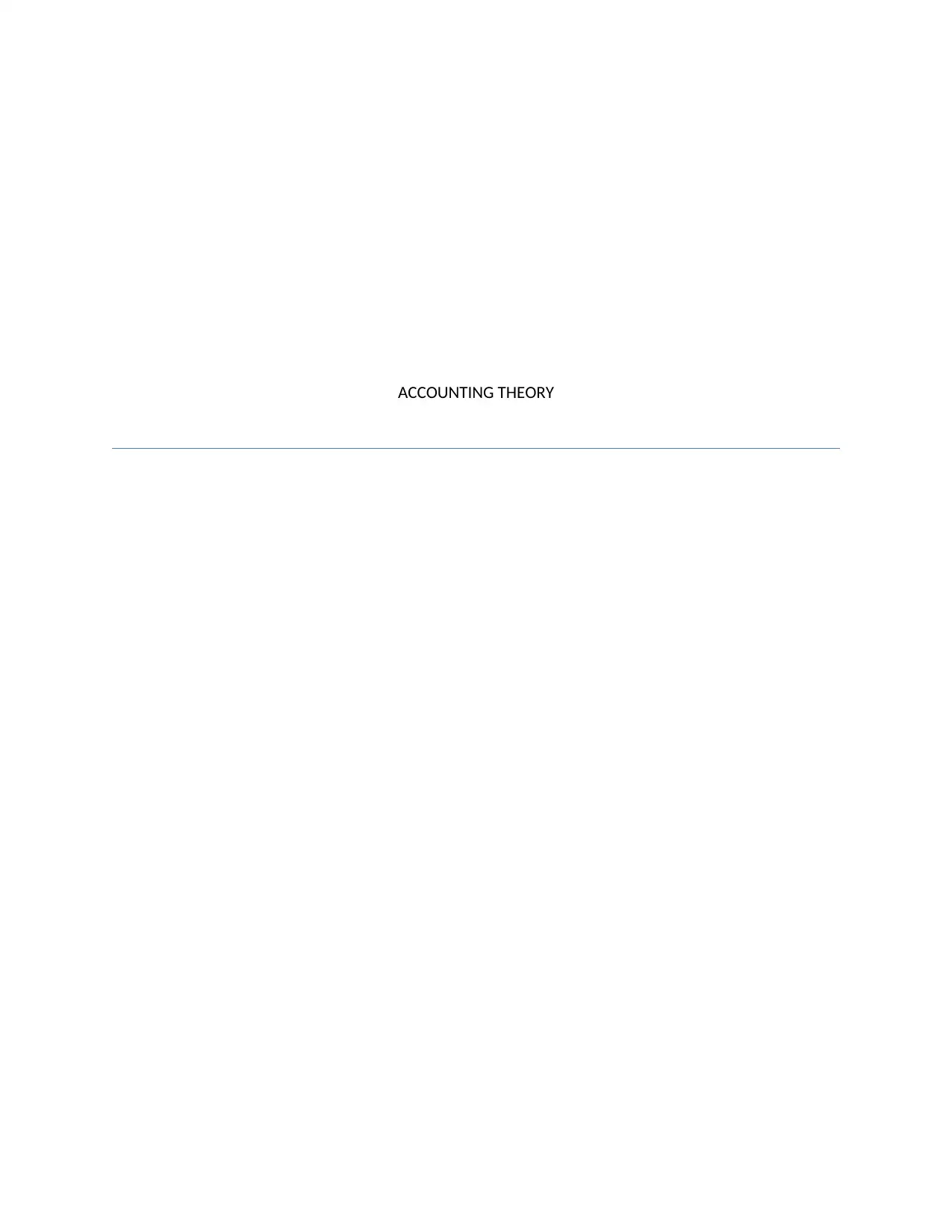
ACCOUNTING THEORY
Paraphrase This Document
Need a fresh take? Get an instant paraphrase of this document with our AI Paraphraser
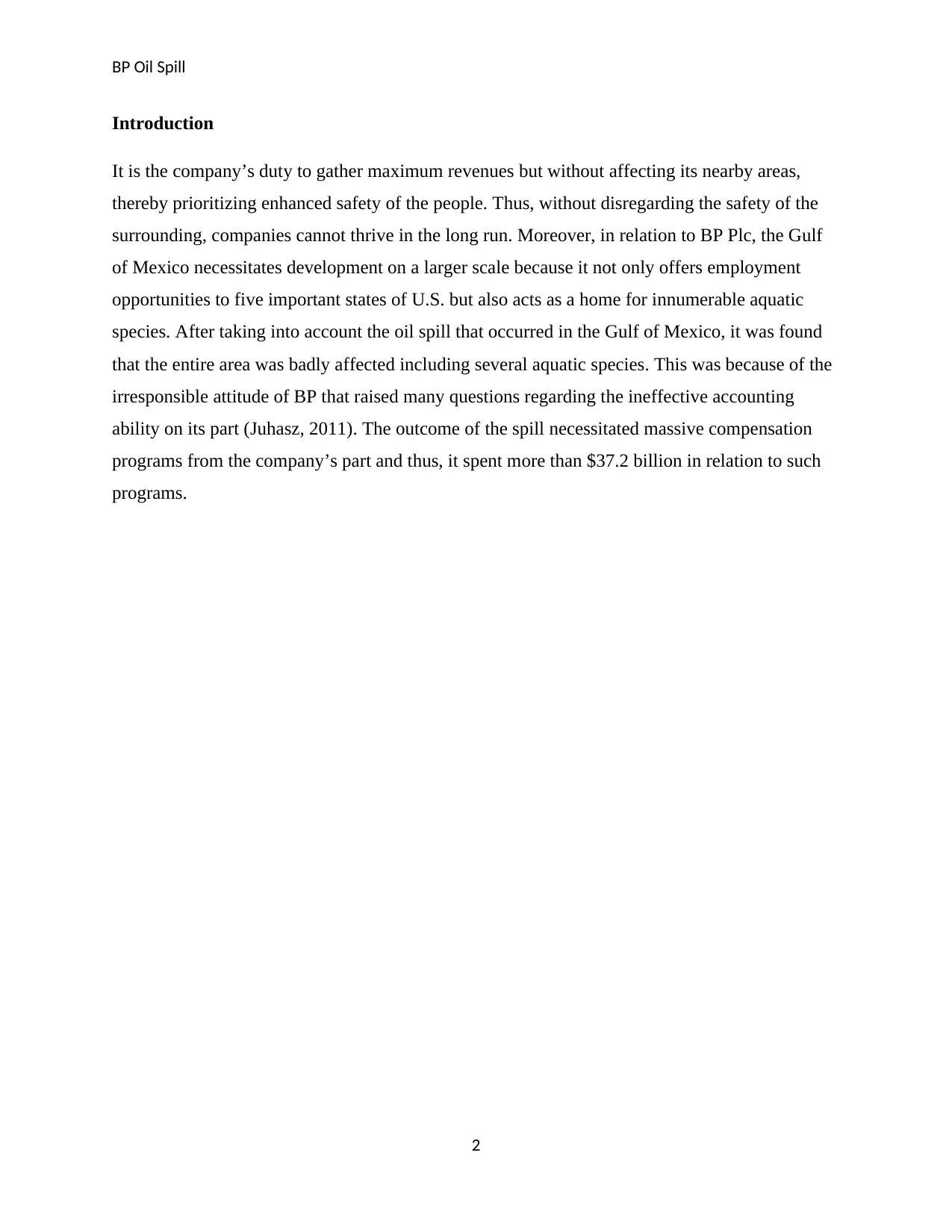
BP Oil Spill
Introduction
It is the company’s duty to gather maximum revenues but without affecting its nearby areas,
thereby prioritizing enhanced safety of the people. Thus, without disregarding the safety of the
surrounding, companies cannot thrive in the long run. Moreover, in relation to BP Plc, the Gulf
of Mexico necessitates development on a larger scale because it not only offers employment
opportunities to five important states of U.S. but also acts as a home for innumerable aquatic
species. After taking into account the oil spill that occurred in the Gulf of Mexico, it was found
that the entire area was badly affected including several aquatic species. This was because of the
irresponsible attitude of BP that raised many questions regarding the ineffective accounting
ability on its part (Juhasz, 2011). The outcome of the spill necessitated massive compensation
programs from the company’s part and thus, it spent more than $37.2 billion in relation to such
programs.
2
Introduction
It is the company’s duty to gather maximum revenues but without affecting its nearby areas,
thereby prioritizing enhanced safety of the people. Thus, without disregarding the safety of the
surrounding, companies cannot thrive in the long run. Moreover, in relation to BP Plc, the Gulf
of Mexico necessitates development on a larger scale because it not only offers employment
opportunities to five important states of U.S. but also acts as a home for innumerable aquatic
species. After taking into account the oil spill that occurred in the Gulf of Mexico, it was found
that the entire area was badly affected including several aquatic species. This was because of the
irresponsible attitude of BP that raised many questions regarding the ineffective accounting
ability on its part (Juhasz, 2011). The outcome of the spill necessitated massive compensation
programs from the company’s part and thus, it spent more than $37.2 billion in relation to such
programs.
2
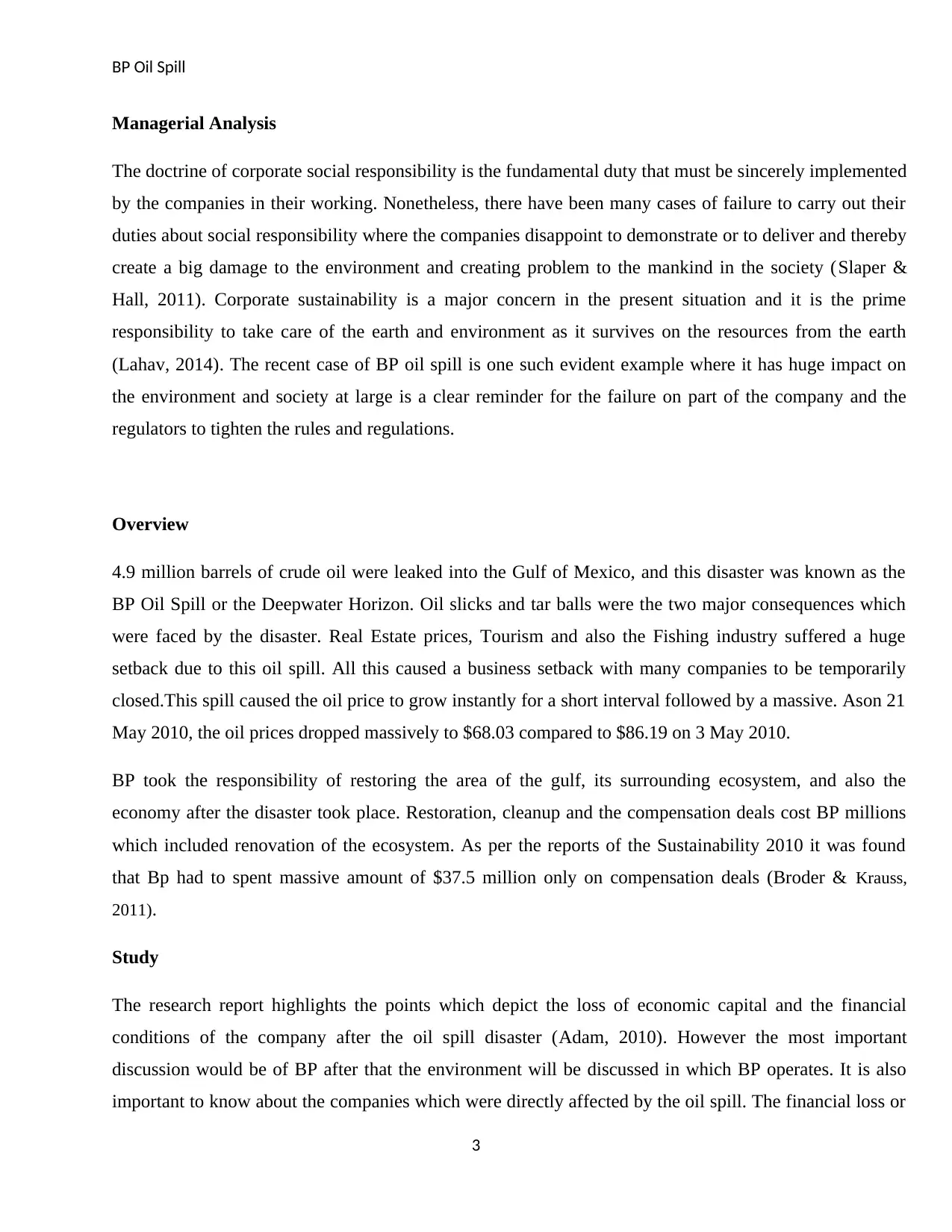
BP Oil Spill
Managerial Analysis
The doctrine of corporate social responsibility is the fundamental duty that must be sincerely implemented
by the companies in their working. Nonetheless, there have been many cases of failure to carry out their
duties about social responsibility where the companies disappoint to demonstrate or to deliver and thereby
create a big damage to the environment and creating problem to the mankind in the society (Slaper &
Hall, 2011). Corporate sustainability is a major concern in the present situation and it is the prime
responsibility to take care of the earth and environment as it survives on the resources from the earth
(Lahav, 2014). The recent case of BP oil spill is one such evident example where it has huge impact on
the environment and society at large is a clear reminder for the failure on part of the company and the
regulators to tighten the rules and regulations.
Overview
4.9 million barrels of crude oil were leaked into the Gulf of Mexico, and this disaster was known as the
BP Oil Spill or the Deepwater Horizon. Oil slicks and tar balls were the two major consequences which
were faced by the disaster. Real Estate prices, Tourism and also the Fishing industry suffered a huge
setback due to this oil spill. All this caused a business setback with many companies to be temporarily
closed.This spill caused the oil price to grow instantly for a short interval followed by a massive. Ason 21
May 2010, the oil prices dropped massively to $68.03 compared to $86.19 on 3 May 2010.
BP took the responsibility of restoring the area of the gulf, its surrounding ecosystem, and also the
economy after the disaster took place. Restoration, cleanup and the compensation deals cost BP millions
which included renovation of the ecosystem. As per the reports of the Sustainability 2010 it was found
that Bp had to spent massive amount of $37.5 million only on compensation deals (Broder & Krauss,
2011).
Study
The research report highlights the points which depict the loss of economic capital and the financial
conditions of the company after the oil spill disaster (Adam, 2010). However the most important
discussion would be of BP after that the environment will be discussed in which BP operates. It is also
important to know about the companies which were directly affected by the oil spill. The financial loss or
3
Managerial Analysis
The doctrine of corporate social responsibility is the fundamental duty that must be sincerely implemented
by the companies in their working. Nonetheless, there have been many cases of failure to carry out their
duties about social responsibility where the companies disappoint to demonstrate or to deliver and thereby
create a big damage to the environment and creating problem to the mankind in the society (Slaper &
Hall, 2011). Corporate sustainability is a major concern in the present situation and it is the prime
responsibility to take care of the earth and environment as it survives on the resources from the earth
(Lahav, 2014). The recent case of BP oil spill is one such evident example where it has huge impact on
the environment and society at large is a clear reminder for the failure on part of the company and the
regulators to tighten the rules and regulations.
Overview
4.9 million barrels of crude oil were leaked into the Gulf of Mexico, and this disaster was known as the
BP Oil Spill or the Deepwater Horizon. Oil slicks and tar balls were the two major consequences which
were faced by the disaster. Real Estate prices, Tourism and also the Fishing industry suffered a huge
setback due to this oil spill. All this caused a business setback with many companies to be temporarily
closed.This spill caused the oil price to grow instantly for a short interval followed by a massive. Ason 21
May 2010, the oil prices dropped massively to $68.03 compared to $86.19 on 3 May 2010.
BP took the responsibility of restoring the area of the gulf, its surrounding ecosystem, and also the
economy after the disaster took place. Restoration, cleanup and the compensation deals cost BP millions
which included renovation of the ecosystem. As per the reports of the Sustainability 2010 it was found
that Bp had to spent massive amount of $37.5 million only on compensation deals (Broder & Krauss,
2011).
Study
The research report highlights the points which depict the loss of economic capital and the financial
conditions of the company after the oil spill disaster (Adam, 2010). However the most important
discussion would be of BP after that the environment will be discussed in which BP operates. It is also
important to know about the companies which were directly affected by the oil spill. The financial loss or
3
⊘ This is a preview!⊘
Do you want full access?
Subscribe today to unlock all pages.

Trusted by 1+ million students worldwide
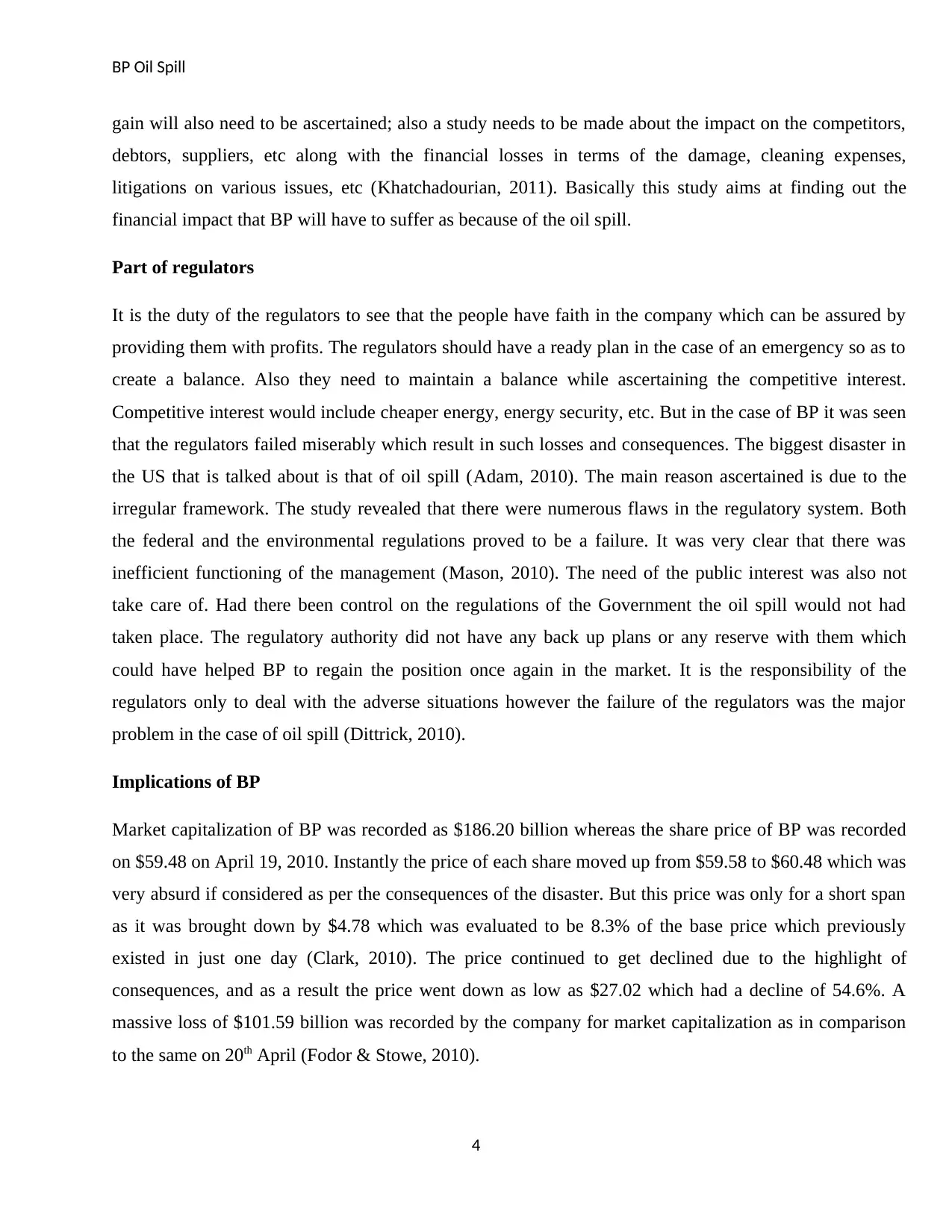
BP Oil Spill
gain will also need to be ascertained; also a study needs to be made about the impact on the competitors,
debtors, suppliers, etc along with the financial losses in terms of the damage, cleaning expenses,
litigations on various issues, etc (Khatchadourian, 2011). Basically this study aims at finding out the
financial impact that BP will have to suffer as because of the oil spill.
Part of regulators
It is the duty of the regulators to see that the people have faith in the company which can be assured by
providing them with profits. The regulators should have a ready plan in the case of an emergency so as to
create a balance. Also they need to maintain a balance while ascertaining the competitive interest.
Competitive interest would include cheaper energy, energy security, etc. But in the case of BP it was seen
that the regulators failed miserably which result in such losses and consequences. The biggest disaster in
the US that is talked about is that of oil spill (Adam, 2010). The main reason ascertained is due to the
irregular framework. The study revealed that there were numerous flaws in the regulatory system. Both
the federal and the environmental regulations proved to be a failure. It was very clear that there was
inefficient functioning of the management (Mason, 2010). The need of the public interest was also not
take care of. Had there been control on the regulations of the Government the oil spill would not had
taken place. The regulatory authority did not have any back up plans or any reserve with them which
could have helped BP to regain the position once again in the market. It is the responsibility of the
regulators only to deal with the adverse situations however the failure of the regulators was the major
problem in the case of oil spill (Dittrick, 2010).
Implications of BP
Market capitalization of BP was recorded as $186.20 billion whereas the share price of BP was recorded
on $59.48 on April 19, 2010. Instantly the price of each share moved up from $59.58 to $60.48 which was
very absurd if considered as per the consequences of the disaster. But this price was only for a short span
as it was brought down by $4.78 which was evaluated to be 8.3% of the base price which previously
existed in just one day (Clark, 2010). The price continued to get declined due to the highlight of
consequences, and as a result the price went down as low as $27.02 which had a decline of 54.6%. A
massive loss of $101.59 billion was recorded by the company for market capitalization as in comparison
to the same on 20th April (Fodor & Stowe, 2010).
4
gain will also need to be ascertained; also a study needs to be made about the impact on the competitors,
debtors, suppliers, etc along with the financial losses in terms of the damage, cleaning expenses,
litigations on various issues, etc (Khatchadourian, 2011). Basically this study aims at finding out the
financial impact that BP will have to suffer as because of the oil spill.
Part of regulators
It is the duty of the regulators to see that the people have faith in the company which can be assured by
providing them with profits. The regulators should have a ready plan in the case of an emergency so as to
create a balance. Also they need to maintain a balance while ascertaining the competitive interest.
Competitive interest would include cheaper energy, energy security, etc. But in the case of BP it was seen
that the regulators failed miserably which result in such losses and consequences. The biggest disaster in
the US that is talked about is that of oil spill (Adam, 2010). The main reason ascertained is due to the
irregular framework. The study revealed that there were numerous flaws in the regulatory system. Both
the federal and the environmental regulations proved to be a failure. It was very clear that there was
inefficient functioning of the management (Mason, 2010). The need of the public interest was also not
take care of. Had there been control on the regulations of the Government the oil spill would not had
taken place. The regulatory authority did not have any back up plans or any reserve with them which
could have helped BP to regain the position once again in the market. It is the responsibility of the
regulators only to deal with the adverse situations however the failure of the regulators was the major
problem in the case of oil spill (Dittrick, 2010).
Implications of BP
Market capitalization of BP was recorded as $186.20 billion whereas the share price of BP was recorded
on $59.48 on April 19, 2010. Instantly the price of each share moved up from $59.58 to $60.48 which was
very absurd if considered as per the consequences of the disaster. But this price was only for a short span
as it was brought down by $4.78 which was evaluated to be 8.3% of the base price which previously
existed in just one day (Clark, 2010). The price continued to get declined due to the highlight of
consequences, and as a result the price went down as low as $27.02 which had a decline of 54.6%. A
massive loss of $101.59 billion was recorded by the company for market capitalization as in comparison
to the same on 20th April (Fodor & Stowe, 2010).
4
Paraphrase This Document
Need a fresh take? Get an instant paraphrase of this document with our AI Paraphraser
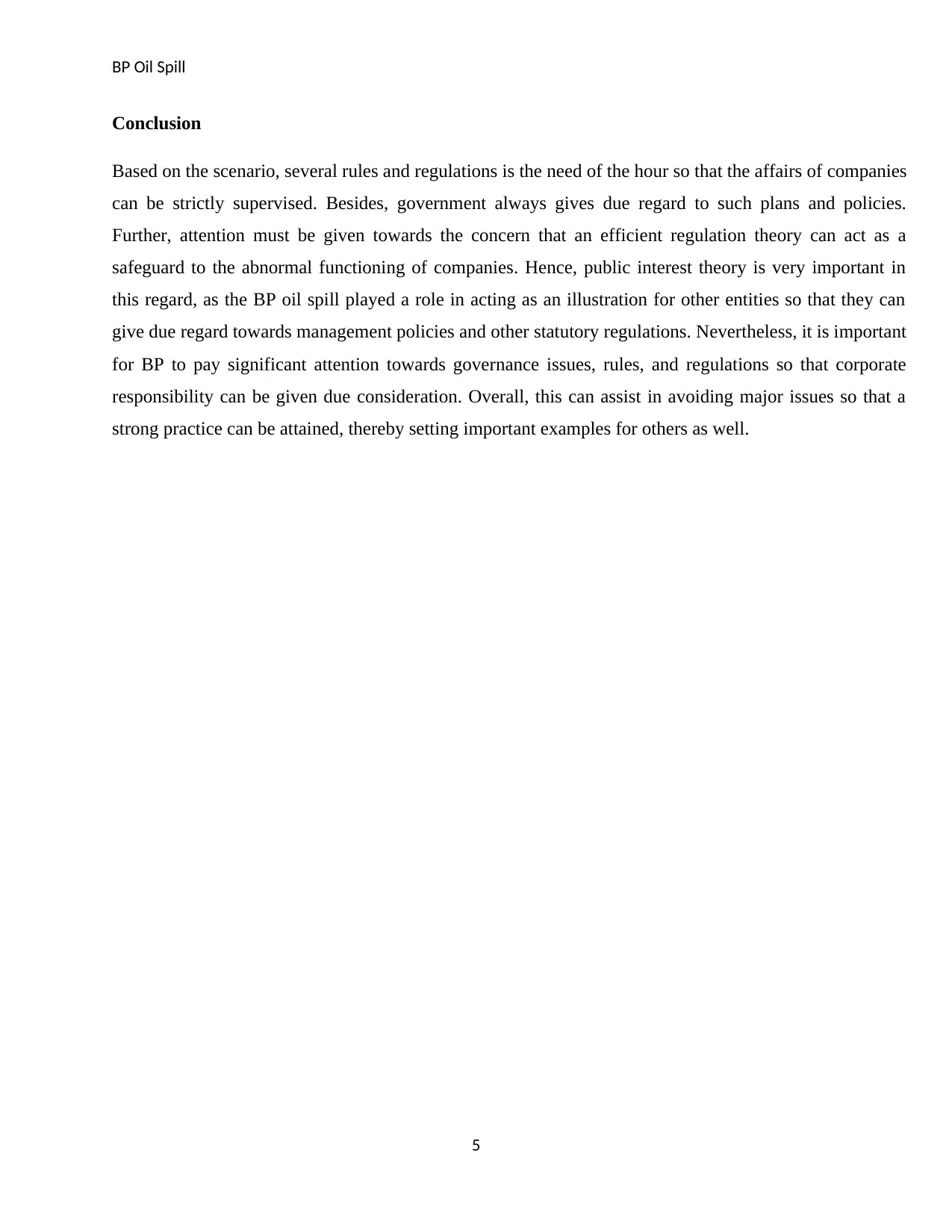
BP Oil Spill
Conclusion
Based on the scenario, several rules and regulations is the need of the hour so that the affairs of companies
can be strictly supervised. Besides, government always gives due regard to such plans and policies.
Further, attention must be given towards the concern that an efficient regulation theory can act as a
safeguard to the abnormal functioning of companies. Hence, public interest theory is very important in
this regard, as the BP oil spill played a role in acting as an illustration for other entities so that they can
give due regard towards management policies and other statutory regulations. Nevertheless, it is important
for BP to pay significant attention towards governance issues, rules, and regulations so that corporate
responsibility can be given due consideration. Overall, this can assist in avoiding major issues so that a
strong practice can be attained, thereby setting important examples for others as well.
5
Conclusion
Based on the scenario, several rules and regulations is the need of the hour so that the affairs of companies
can be strictly supervised. Besides, government always gives due regard to such plans and policies.
Further, attention must be given towards the concern that an efficient regulation theory can act as a
safeguard to the abnormal functioning of companies. Hence, public interest theory is very important in
this regard, as the BP oil spill played a role in acting as an illustration for other entities so that they can
give due regard towards management policies and other statutory regulations. Nevertheless, it is important
for BP to pay significant attention towards governance issues, rules, and regulations so that corporate
responsibility can be given due consideration. Overall, this can assist in avoiding major issues so that a
strong practice can be attained, thereby setting important examples for others as well.
5
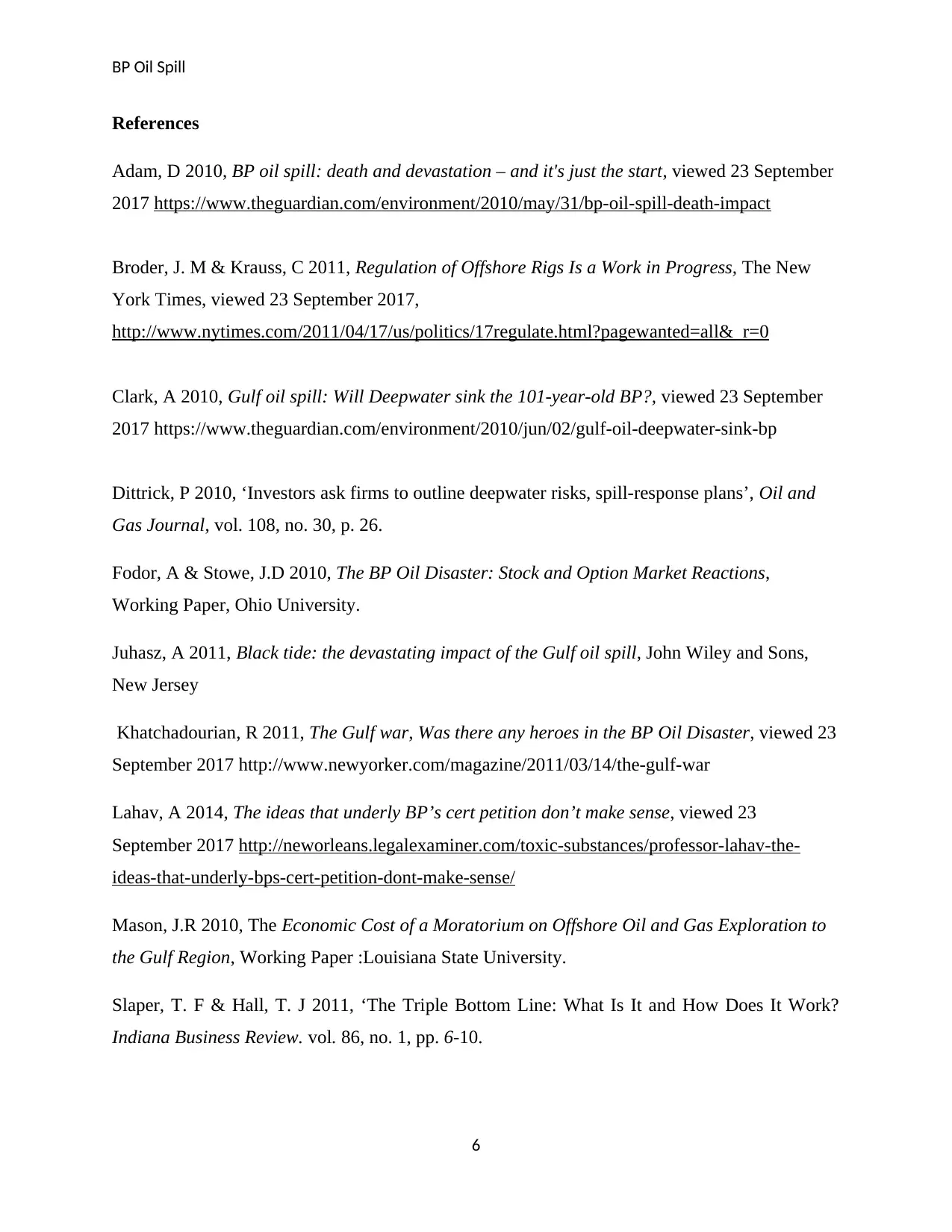
BP Oil Spill
References
Adam, D 2010, BP oil spill: death and devastation – and it's just the start, viewed 23 September
2017 https://www.theguardian.com/environment/2010/may/31/bp-oil-spill-death-impact
Broder, J. M & Krauss, C 2011, Regulation of Offshore Rigs Is a Work in Progress, The New
York Times, viewed 23 September 2017,
http://www.nytimes.com/2011/04/17/us/politics/17regulate.html?pagewanted=all&_r=0
Clark, A 2010, Gulf oil spill: Will Deepwater sink the 101-year-old BP?, viewed 23 September
2017 https://www.theguardian.com/environment/2010/jun/02/gulf-oil-deepwater-sink-bp
Dittrick, P 2010, ‘Investors ask firms to outline deepwater risks, spill-response plans’, Oil and
Gas Journal, vol. 108, no. 30, p. 26.
Fodor, A & Stowe, J.D 2010, The BP Oil Disaster: Stock and Option Market Reactions,
Working Paper, Ohio University.
Juhasz, A 2011, Black tide: the devastating impact of the Gulf oil spill, John Wiley and Sons,
New Jersey
Khatchadourian, R 2011, The Gulf war, Was there any heroes in the BP Oil Disaster, viewed 23
September 2017 http://www.newyorker.com/magazine/2011/03/14/the-gulf-war
Lahav, A 2014, The ideas that underly BP’s cert petition don’t make sense, viewed 23
September 2017 http://neworleans.legalexaminer.com/toxic-substances/professor-lahav-the-
ideas-that-underly-bps-cert-petition-dont-make-sense/
Mason, J.R 2010, The Economic Cost of a Moratorium on Offshore Oil and Gas Exploration to
the Gulf Region, Working Paper :Louisiana State University.
Slaper, T. F & Hall, T. J 2011, ‘The Triple Bottom Line: What Is It and How Does It Work?
Indiana Business Review. vol. 86, no. 1, pp. 6-10.
6
References
Adam, D 2010, BP oil spill: death and devastation – and it's just the start, viewed 23 September
2017 https://www.theguardian.com/environment/2010/may/31/bp-oil-spill-death-impact
Broder, J. M & Krauss, C 2011, Regulation of Offshore Rigs Is a Work in Progress, The New
York Times, viewed 23 September 2017,
http://www.nytimes.com/2011/04/17/us/politics/17regulate.html?pagewanted=all&_r=0
Clark, A 2010, Gulf oil spill: Will Deepwater sink the 101-year-old BP?, viewed 23 September
2017 https://www.theguardian.com/environment/2010/jun/02/gulf-oil-deepwater-sink-bp
Dittrick, P 2010, ‘Investors ask firms to outline deepwater risks, spill-response plans’, Oil and
Gas Journal, vol. 108, no. 30, p. 26.
Fodor, A & Stowe, J.D 2010, The BP Oil Disaster: Stock and Option Market Reactions,
Working Paper, Ohio University.
Juhasz, A 2011, Black tide: the devastating impact of the Gulf oil spill, John Wiley and Sons,
New Jersey
Khatchadourian, R 2011, The Gulf war, Was there any heroes in the BP Oil Disaster, viewed 23
September 2017 http://www.newyorker.com/magazine/2011/03/14/the-gulf-war
Lahav, A 2014, The ideas that underly BP’s cert petition don’t make sense, viewed 23
September 2017 http://neworleans.legalexaminer.com/toxic-substances/professor-lahav-the-
ideas-that-underly-bps-cert-petition-dont-make-sense/
Mason, J.R 2010, The Economic Cost of a Moratorium on Offshore Oil and Gas Exploration to
the Gulf Region, Working Paper :Louisiana State University.
Slaper, T. F & Hall, T. J 2011, ‘The Triple Bottom Line: What Is It and How Does It Work?
Indiana Business Review. vol. 86, no. 1, pp. 6-10.
6
⊘ This is a preview!⊘
Do you want full access?
Subscribe today to unlock all pages.

Trusted by 1+ million students worldwide

BP Oil Spill
7
7
1 out of 7
Related Documents
Your All-in-One AI-Powered Toolkit for Academic Success.
+13062052269
info@desklib.com
Available 24*7 on WhatsApp / Email
![[object Object]](/_next/static/media/star-bottom.7253800d.svg)
Unlock your academic potential
Copyright © 2020–2025 A2Z Services. All Rights Reserved. Developed and managed by ZUCOL.





